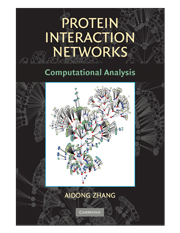Book contents
- Frontmatter
- Contents
- Preface
- 1 Introduction
- 2 Experimental Approaches to Generation of PPI Data
- 3 Computational Methods for the Prediction of PPIs
- 4 Basic Properties and Measurements of Protein Interaction Networks
- 5 Modularity Analysis of Protein Interaction Networks
- 6 Topological Analysis of Protein Interaction Networks
- 7 Distance-Based Modularity Analysis
- 8 Graph-Theoretic Approaches to Modularity Analysis
- 9 Flow-Based Analysis of Protein Interaction Networks
- 10 Statistics and Machine Learning Based Analysis of Protein Interaction Networks
- 11 Integration of GO into the Analysis of Protein Interaction Networks
- 12 Data Fusion in the Analysis of Protein Interaction Networks
- 13 Conclusion
- Bibliography
- Index
3 - Computational Methods for the Prediction of PPIs
Published online by Cambridge University Press: 28 January 2010
- Frontmatter
- Contents
- Preface
- 1 Introduction
- 2 Experimental Approaches to Generation of PPI Data
- 3 Computational Methods for the Prediction of PPIs
- 4 Basic Properties and Measurements of Protein Interaction Networks
- 5 Modularity Analysis of Protein Interaction Networks
- 6 Topological Analysis of Protein Interaction Networks
- 7 Distance-Based Modularity Analysis
- 8 Graph-Theoretic Approaches to Modularity Analysis
- 9 Flow-Based Analysis of Protein Interaction Networks
- 10 Statistics and Machine Learning Based Analysis of Protein Interaction Networks
- 11 Integration of GO into the Analysis of Protein Interaction Networks
- 12 Data Fusion in the Analysis of Protein Interaction Networks
- 13 Conclusion
- Bibliography
- Index
Summary
INTRODUCTION
The yeast two-hybrid (Y2H) system and other experimental approaches described in Chapter 2 provide useful tools for the detection of protein-protein interactions (PPIs) between specified proteins that may occur in many possible combinations. The widespread application of these methods has generated a substantial bank of information about such interactions. However, as pointed out in Chapter 2, the data generated through these approaches may be unreliable and may not be completely inclusive of all possible PPIs. In order to form an understanding of the total universe of potential interactions, including those not detected by these methods, it is useful to develop approaches to predict the full range of possible interactions between proteins. The accurate prediction of PPIs is therefore an important goal in the field of molecular recognition.
A variety of computational methods have been applied to supplement the interactions that have been detected experimentally. In addition, these methods can assess the reliability of experimentally derived interaction data, which are prone to error. The computational methods for in-silico prediction include genomicscale approaches [80, 98, 208, 209, 235, 248], sequence-based approaches [212, 287, 322, 338], structure-based approaches [10, 11, 22, 95, 282], learning-based approaches [42, 43, 127, 160, 236], and network-topology-based approaches [19, 62, 125, 245, 269, 270]. The individual PPI data can be taken from publicly available databases, such as MIPS [130, 214], DIP [271, 327], MINT [59, 340], IntAct [141, 178], BioGRID [289], and HPRD [219, 251, 252], as described in Chapter 2.
GENOME-SCALE APPROACHES
The availability of complete genomes for various organisms has enabled the prediction of PPIs at a genomic scale. Genomic-scale approaches typically perform a comparison of gene sequences across genomes and are often justified on the basis of the correlated evolutionary mechanisms of genes.
- Type
- Chapter
- Information
- Protein Interaction NetworksComputational Analysis, pp. 21 - 32Publisher: Cambridge University PressPrint publication year: 2009



